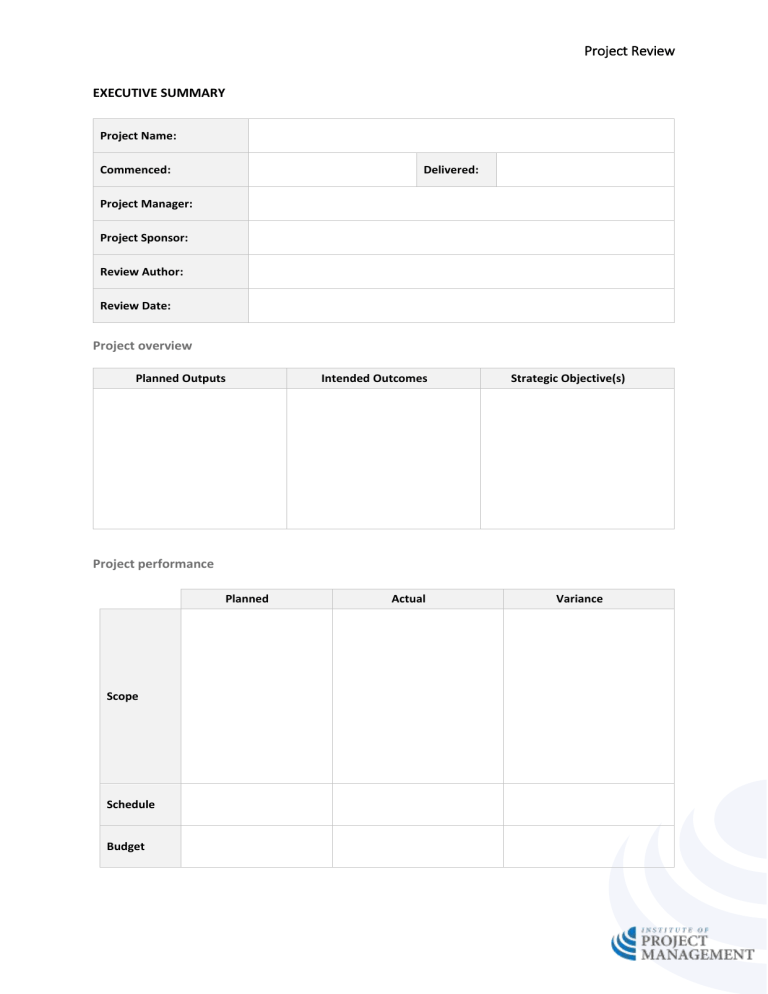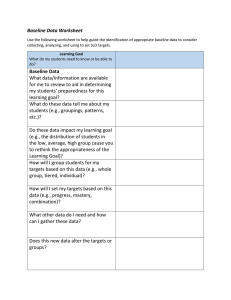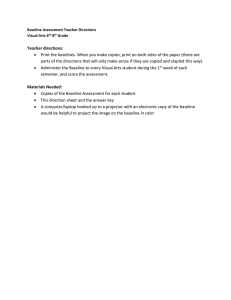
Project Review EXECUTIVE SUMMARY Project Name: Commenced: Delivered: Project Manager: Project Sponsor: Review Author: Review Date: Project overview Planned Outputs Intended Outcomes Strategic Objective(s) Project performance Planned Scope Schedule Budget Actual Variance Project Review Top 5 lessons learned 1. <Insert> 2. <Insert> 3. <Insert> 4. <Insert> 5. <Insert> Key recommendations <List the most important SMART actions the organisation should take to ensure that project lessons are learned, shared and implemented to benefit future project delivery.> This template is provided free of charge by the Institute of Project Management under a GNU General Public License. By downloading and using this resource, you accept its terms and conditions of use. In short, you can redistribute and/or modify this template to your heart’s content, but without any warranty (real or implied) about its merchantability or fitness for a particular purpose. This template is offered ‘as is’, and is not supported by a help desk. Please visit http://microsoft.com for editing tips and tricks. You can contact us to learn how this or other project management assets might be customised for your project or organisation. Project Review TABLE OF CONTENTS 1 2 3 PROJECT OVERVIEW........................................................................................................................ 1 1.1 Project description .................................................................................................................. 1 1.2 Intended outcomes ................................................................................................................. 1 1.3 Strategic objectives ................................................................................................................. 1 REVIEW METHODOLOGY ................................................................................................................ 2 2.1 Terms of reference.................................................................................................................. 2 2.2 Primary sources....................................................................................................................... 2 2.3 Secondary sources .................................................................................................................. 2 2.4 Assumptions and constraints .................................................................................................. 2 PROJECT PERFORMANCE ................................................................................................................ 3 3.1 4 5 Performance against baseline plans ....................................................................................... 3 3.1.1 Performance against baseline scope .................................................................................. 3 3.1.2 Performance against baseline schedule ............................................................................. 3 3.1.3 Performance against baseline budget ................................................................................ 3 3.2 Benefits delivered ................................................................................................................... 4 3.3 Benefits yet to be realised ...................................................................................................... 4 3.4 Changes ................................................................................................................................... 4 OPEN ACTIONS ................................................................................................................................ 5 4.1 Open project issues................................................................................................................. 5 4.2 Residual risks ........................................................................................................................... 5 4.3 Handover/training needs ........................................................................................................ 6 4.4 Other required activities ......................................................................................................... 6 LESSONS LEARNED .......................................................................................................................... 7 5.1 Stakeholder identification and communication ..................................................................... 7 5.2 Business case development .................................................................................................... 7 5.3 Scope definition and management ......................................................................................... 7 5.4 Schedule development and control ........................................................................................ 7 5.5 Cost estimating and control .................................................................................................... 7 5.6 Risk identification, prioritisation and treatment .................................................................... 7 5.7 Human resource availability and performance ...................................................................... 8 5.8 Quality planning and control .................................................................................................. 8 5.9 Procurement / contract management .................................................................................... 8 Project Review 5.10 Project governance and change control ................................................................................. 8 5.11 Project delivery and handover ................................................................................................ 8 5.12 Other lessons learned ............................................................................................................. 8 6 PROJECT MANAGEMENT TEMPLATES, TOOLS AND ASSETS ........................................................... 9 7 CONCLUSION ................................................................................................................................... 9 8 RECOMMENDATIONS.................................................................................................................... 10 9 APPENDICES .................................................................................................................................. 11 <To update the table of contents, right-click anywhere in the table and select “Update Field”.> Project Review 1 PROJECT OVERVIEW 1.1 Project description <Briefly describe the background to the project and the problem it was intended to solve and/or the opportunity it was intended to realise.> 1.2 Intended outcomes <List the outcomes intended to be achieved by the project.> 1.3 Strategic objectives <Detail how these outcomes align to the strategic objectives of the performing organisation. Make specific reference to the organisation’s Strategic and/or Annual Business Plan(s) to evidence this.> Page | 1 Project Review 2 REVIEW METHODOLOGY 2.1 Terms of reference <Describe what is included in the review, and what is out of scope for the review.> 2.2 Primary sources <Primary sources are stakeholders you directly spoke to when conducting the project review. These might include internal business resources (such as engineers, finance and HR); external sources (such as contractors or consultants); and end-users (such as other business units and the community). List who you consulted with and how you engaged with them.> 2.3 Secondary sources <Secondary sources come from your ‘desktop’ research and might include authoritative reports, cases, relevant legislation and reviews of like projects etc.> 2.4 Assumptions and constraints <It is also useful to list any assumptions that might be present in your analysis, and the limitations or constraints placed on your review. Included here might be assumptions about (or constraints relating to) scope, schedule, cost, quality, risk, stakeholders (including stakeholders not consulted) and procurements. You should highlight the implications if any of these assumptions is wrong.> Page | 2 Project Review 3 PROJECT PERFORMANCE 3.1 Performance against baseline plans Planned Actual Variance Schedule Budget 3.1.1 Performance against baseline scope <Discuss how the project performed against its originally planned scope, including an explanation of any shortfalls and/or opportunities or innovations realised.> 3.1.2 Performance against baseline schedule <Discuss how the project performed against its originally planned schedule, including an explanation of any shortfalls and/or opportunities or innovations realised.> 3.1.3 Performance against baseline budget <Discuss how the project performed against its originally planned budget, including an explanation of any shortfalls and/or opportunities or innovations realised.> Page | 3 Project Review 3.2 Benefits delivered <Provide details of the benefits that have been achieved as a result of project implementation (ie. those benefits that can be seen and measured at this point in time. Be sure to include details of how these benefits have been measured.> 3.3 Benefits yet to be realised <Detail which benefits, as outlined in the project’s Business Case, have not been achieved as a result of implementation but have been identified for later realisation. Be sure to include details of when these will be achieved (including any prerequisites) and how they will be measured.> 3.4 Changes <Where changes were authorised during the project (eg relating to scope, time, cost, quality), describe the effect of each change on the Project Plan and achievements against the intended project outcomes.> Page | 4 Project Review 4 OPEN ACTIONS 4.1 Open project issues Issue description 4.2 Owner Proposed treatment Owner Residual risks Risk description Page | 5 Proposed action Project Review 4.3 Handover/training needs <Identify any additional handover or training requirements, if any, that are required post-project.> 4.4 Other required activities <Provide an overview of any operational activities that are proposed to further enhance project outputs or outcomes.> Page | 6 Project Review 5 LESSONS LEARNED 5.1 Stakeholder identification and communication <What worked well? Where are the opportunities for improvement?> 5.2 Business case development <What worked well? Where are the opportunities for improvement?> 5.3 Scope definition and management <What worked well? Where are the opportunities for improvement?> 5.4 Schedule development and control <What worked well? Where are the opportunities for improvement?> 5.5 Cost estimating and control <What worked well? Where are the opportunities for improvement?> 5.6 Risk identification, prioritisation and treatment <What worked well? Where are the opportunities for improvement?> Page | 7 Project Review 5.7 Human resource availability and performance <What worked well? Where are the opportunities for improvement?> 5.8 Quality planning and control <What worked well? Where are the opportunities for improvement?> 5.9 Procurement / contract management <What worked well? Where are the opportunities for improvement?> 5.10 Project governance and change control <What worked well? Where are the opportunities for improvement?> 5.11 Project delivery and handover <What worked well? Where are the opportunities for improvement?> 5.12 Other lessons learned <What worked well? Where are the opportunities for improvement?> Page | 8 Project Review 6 PROJECT MANAGEMENT TEMPLATES, TOOLS AND ASSETS <Identify the key documents, systems and software used to manage the project, and discuss the extent to which they assisted or impeded project delivery. Identify what worked well, as well as opportunities for improvement.> 7 CONCLUSION <Summarise your overall impressions of project performance.> Page | 9 Project Review 8 RECOMMENDATIONS <Describe the SMART actions the organisation should take to ensure that project lessons are learned, shared and implemented to benefit future project delivery.> Page | 10 Project Review 9 APPENDICES This section is optional. Where necessary, appendices can be attached to provide any relevant supporting information, such as: a glossary listing key terms and abbreviations used in the Review a list of stakeholders surveyed or interviewed a copy of survey questions a summary of individual stakeholders comments gathered through the investigative process a list of project documents examined during the Review, and examples of tools or templates referred to within the Review Do not append documents or information not referred to in the body of the Review. Page | 11


